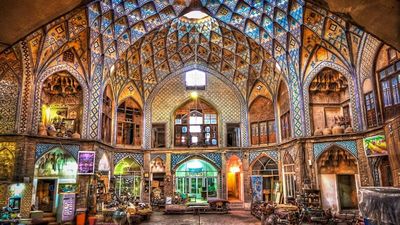Speaking in an exclusive interview with Iran Daily, Ahmad Danaeinia added that some sections of the ancient bazaar were destroyed and remained abandoned for a long period of time, noting that the implementation of the restoration project would require a lot of money and time.
“Efforts are underway to involve the private sector in the project. The move is expected to help achieve the desired goals in the shortest period of time,” he noted.
He said that a committee was formed to supervise the implementation of the renovation project and help facilitate the global registration of the historical bazaar.
Danaeinia added that the ancient bazaar, with a length of three kilometers, includes several sections, a cistern, a mosque, a school, a caravanserai, a bathhouse and the shrine of an Imamzadeh.
“A large number of people with various occupations are working in the bazaar including blacksmiths, goldsmiths, shoemakers and dyers,” he noted.
The official observed that the Kashan Bazaar, which is one of the largest in the country, has very specific architectural features.
He stated that the location of Kashan on the Silk Road between the two large cities of Isfahan (capital of Safavid Dynasty (1501-1736) and Tehran (capital of Qajar Dynasty 1789-1925) helped increase the economic, cultural and social importance of the city. Therefore, the historical bazaar of the city was developed to meet the requirements of local people.
Danaeinia noted that Kashan has been one of the most important centers of handwoven carpet production and sale in the country since a long time ago, noting that 33 related businesses, from livestock breeding to carpet dying and weaving, are active in the city.
He said that a large number of carpet designers, weavers and sellers are working in Kashan Bazaar.
He noted that beautiful architectural decorations were used in the building of the ancient bazaar to attract the attention of Iranian and foreign traders who had commercial relations with the merchants of Kashan.
Referring to the history of the monument he said that no information is available about the date of its establishment because bazaars were built in different parts of the world since human beings started to settle in one place and carry out trade with one another.
He said that the historical bazaar was developed significantly during the Safavid Era, pointing out that a heavy earthquake occurred in Kashan in 1778, at the end of the Zandieh Period (1751-1794 CE), which caused serious damage to the bazaar.
He noted that the bazaar was rebuilt on the old layers of the destroyed structure during the Qajar Period (1789-1925 CE) thanks to the efforts undertaken by the architects of the city and the then-governor of Kashan Abdulghafar Kashi.
Source: Iran Daily

